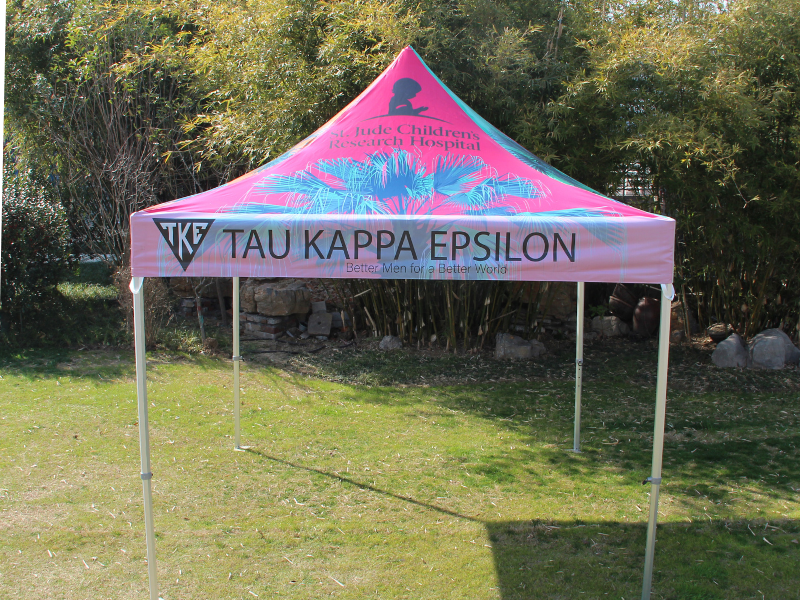In the competitive world of business, making a strong impression at events, trade shows, and outdoor gatherings is essential. One of the most powerful tools in your branding arsenal can be owning a custom printed tent. Not only does it provide shelter, but it also serves as a bold, eye-catching platform to communicate your brand’s message. However, to ensure your tent delivers the desired impact, getting the artwork right from the start is crucial.
This guide will walk you through everything you need to know about the artwork requirements for custom printed canopies and tents. By the end, you'll have a clear understanding of how to prepare your design files, why resolution is critical, and how to avoid common pitfalls that could compromise the final product.
Why Custom Printed Tents Are Essential for Your Brand
Custom printed tents offer businesses and organizations a unique opportunity to showcase their brand in a vibrant, high-visibility format. Whether at a trade show, community event, or outdoor market, a branded tent helps you stand out, attract attention, and create a memorable experience for your audience. But to achieve the best results, your design must be crisp, clear, and perfectly suited to the size of the tent.
Artwork Requirements: The Foundation of a Great Design
Getting the artwork right is essential to ensuring your custom tent looks professional and grabs attention. Here’s what you need to know:
1. Acceptable File Types
To guarantee your design prints flawlessly on a large tent, using the correct file types is vital. We accept the following formats:
- Adobe Illustrator: .ai, .eps, .pdf
- Photoshop: .psd
- High-Resolution Images: .jpg, .png, .gif, .tiff
These file types are optimized for high-quality printing, preserving the detail and clarity needed for large-scale prints.
2. Resolution Requirements: Why DPI Matters
Resolution is a critical aspect of your artwork. DPI, or Dots Per Inch, measures the level of detail in your image. For custom printed tents, all raster artwork (like .jpg, .png, .gif, .tiff) should be at least 200 DPI at full size (100% scale). However, we recommend 300 DPI for the best results. High-resolution images ensure your design remains sharp and clear, even when printed on a large surface.
3. Unacceptable File Types
Certain file types are not suitable for high-quality printing on large tents. Avoid using:
- Files from InDesign, Corel Draw, and Microsoft Programs: Word, Excel, PowerPoint
- Low-Resolution Images: These will appear blurry or pixelated when printed large.
- Files Over 1GB in Size: Large files can slow down production and cause processing issues.
By avoiding these file types, you ensure a smoother production process and a final product that meets your expectations.
The Role of the Digital Sample
Once you’ve submitted your artwork, our team will create a digital sample of your tent. This is an important step because it shows you exactly how your design will look once printed. Keep in mind that while a digital sample is a great preview, it might not perfectly represent how the design will appear when printed on a large tent. It’s crucial to ensure your original artwork is high-resolution to avoid any blurriness or pixelation in the final product.
Common Pitfalls and How to Avoid Them
1. Low Resolution Files
One of the most common issues we encounter is low-resolution files. While they might look fine on a small screen, they can become blurry when printed on a large tent. If your file is low-resolution, we’ll notify you and offer options to improve it, such as using our logo recreation service.
2. Using Unfit File Types
Many customers attempt to use files from programs like Word or PowerPoint for their designs. Unfortunately, these programs are not built for high-quality printing, and the resulting files often lack the necessary detail and resolution. Always use professional design software like Adobe Illustrator or Photoshop to ensure the best results.
3. Misunderstanding the Digital Sample
Remember that the digital sample is just a preview and might not reveal issues like low resolution. Trust the advice of your printing experts if they suggest changes to your design to improve the final product.
Why High-Resolution Images Are Non-Negotiable
High-resolution images are essential for ensuring that your custom tent design looks as good in real life as it does on your screen. Low-resolution images can lead to pixelation, where the image appears blocky and unclear when printed on a large surface. This can significantly detract from the professional appearance you’re aiming for. By using high-resolution images from the start, you guarantee that your tent will make a strong visual impact at any event.
We're Here to Help
If you’re unsure whether your artwork meets the requirements, don’t worry—we’re here to help. Our team offers logo recreation services at $80 per hour to get your design print-ready. Whether it’s adjusting the resolution or converting file types, we handle the technical details so you don’t have to.
Invest in Quality for Maximum Impact
Your custom printed tent is more than just a shelter; it’s a powerful marketing tool that represents your brand. Investing time and effort into getting the artwork right will pay off in the form of a professional, eye-catching tent that stands out from the crowd. By following these artwork guidelines, you can ensure that your design is perfectly suited for large-scale printing and that your brand makes a lasting impression.
Ready to take your brand to the next level with a custom printed tent? Contact us today to get started!



